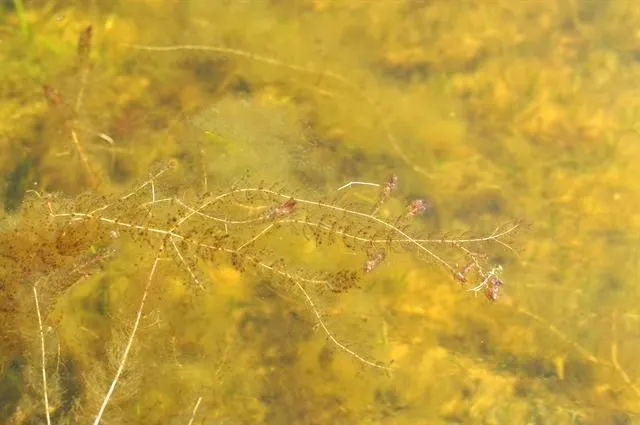
Author: DC.
Bibliography: J.B.A.M.de Lamarck & A.P.de Candolle, Fl. Franç., ed. 3, 5: 529 (1815)
Year: 1815
Status: accepted
Rank: species
Genus: Myriophyllum
Vegetable: False
Observations: Subarctic America to NC. & NE. U.S.A., Azores, NW. Africa, Europe, C. & S. China
Alternateflower watermilfoil, scientifically referred to as Myriophyllum alterniflorum, is a fascinating aquatic plant belonging to the family Haloragaceae. First described in 1815 by the botanists Jean-Baptiste Antoine Marcel de Lamarck and Alphonse Louis Pierre Pyrame de Candolle, this plant has garnered attention for its widespread distribution and unique characteristics.
This species thrives in various regions across the globe, found predominantly from Subarctic America extending to the northern and eastern United States. Its range also includes the Azores, Northwestern Africa, different parts of Europe, and extends to Central and Southern China, showcasing its adaptability to diverse climatic zones.
The Alternateflower watermilfoil is typically submerged and can be identified by its finely divided, fern-like leaves which give it a delicate appearance. Its name, alterniflorum, indicates its distinctive alternating floral arrangement, setting it apart from other species within the Myriophyllum genus.
Habitats for this watermilfoil include both still and flowing freshwater bodies, such as lakes, ponds, and rivers, where it often plays a crucial role in aquatic ecosystems. It provides habitat and breeding grounds for various aquatic organisms and contributes to the health of freshwater systems by stabilizing sediment and maintaining water clarity.
Botanists and ecologists value Myriophyllum alterniflorum not only for its ecological contributions but also for its potential applications in water management and conservation efforts. This plant can act as a natural bioindicator, helping to monitor the health of aquatic environments and address issues related to water quality.
Throughout its extensive geographical range, Myriophyllum alterniflorum continues to be a subject of study and interest. Its resilience and ecological significance underscore the importance of conserving aquatic plant species that play pivotal roles in maintaining the balance and health of our freshwater ecosystems.
Eng: alternate-flowered water-milfoil, alternateflower watermilfoil, alternate water-milfoil, alternate water milfoil, alternate-leaved water-milfoil, alternate-flowered water milfoil, loose-flowered water-milfoil, slender water-milfoil, slender water milfoil
Deu: armblütiges tausendblatt, wechselblütiges tausendblatt
Dan: hår-tusindblad
Fra: myriophylle à fleurs alternes
Lav: pamišziedu daudzlape
Nld: teer vederkruid
Nor: vassrøllike
Swe: hårslinga
Sme: ruškessuovvi
Ita: millefoglio d’acqua gracile
Cym: myrdd-ddail blodau bob yn ail, myrddail bob yn ail, myrddail cylchynol
Spa: ovas de rio
En: Alternateflower watermilfoil, Alternate-Flower Water-Milfoil, Alternate Water-milfoil, Alternate-flowered water milfoil, Slender Water-milfoil, Slender water milfoil, Alternate-flowered water-milfoil, Alternate Water Milfoil, Alternate-Leaved Water-Milfoil, Loose-flowered water-milfoil
Zh: 互花狐尾藻
Kw: Minfel dowr
Cs: Stolístek střídavokvětý
Da: Hår-tusindblad
Nl: Teer vederkruid
Et: Vahelduvaõiene vesikuusk
Fi: Ruskoärviä
Fr: Myriophylle à fleurs alternes, Myriophylle à feuilles alternes
De: Wechselblütiges Tausendblatt, Armblütiges Tausendblatt
Is: Síkjamari
It: Millefoglio d’acqua gracile, Millefoglio d’Acqua Gracile
Lv: Pamišziedu daudzlape
Lt: Pražangiažiedė plunksnalapė
Se: Ruškessuovvi
No: Tusenblad, Vassrøllike
Pl: Wywłócznik skrętoległy
Ru: Уруть очерёдноцветковая
Es: Ovas de Rio
Sv: Hårslinga
Uk: Водопериця черговоквіткова
Cy: Myrdd-ddail blodau bob yn ail, Myrddail Bob Yn Ail, Myrddail Cylchynol
Taken Sep 3, 2022 by Ruiz de Almirón Lanz (cc-by-sa)
Taken Jan 1, 1900 by EOL − Encyclopedia of Life (cc-by-nc)
Taken Jul 14, 2014 by Tela Botanica − Jean-Christophe RAGUE (cc-by-sa)
Taken Jan 1, 1900 by EOL − Encyclopedia of Life (cc-by-nc)
Taken Jan 1, 1900 by EOL − Encyclopedia of Life (cc-by-nc)
Taken Jun 1, 2022 by Florence Caron (cc-by-sa)
Taken Apr 15, 2005 by Photoflora – Jean-Luc TASSET (©)
Taken Aug 15, 2013 by Photoflora – Jean-Luc TASSET (©)
Taken Jan 1, 1900 by EOL − Encyclopedia of Life (cc-by-nc)
Taken Jan 1, 1900 by EOL − Encyclopedia of Life (cc-by-nc)
Taken Jul 14, 2014 by Tela Botanica − Jean-Christophe RAGUE (cc-by-sa)
Taken Jan 1, 1900 by EOL − Encyclopedia of Life (cc-by-nc)
Taken Jan 1, 1900 by EOL − Encyclopedia of Life (cc-by-nc)
Taken Aug 15, 2013 by Photoflora – Benoit BOCK (©)
Taken Apr 15, 2005 by Photoflora – Jean-Luc TASSET (©)
Taken Apr 15, 2005 by Photoflora – Jean-Luc TASSET (©)
Taken Jan 1, 1970 by Photoflora – L’Abbé COSTE (©)
Taken May 31, 1876 by Tela Botanica − Herbier PONTARLIER-MARICHAL (cc-by-sa)
© copyright of the Board of Trustees of the Royal Botanic Gardens, Kew.
© copyright of the Board of Trustees of the Royal Botanic Gardens, Kew.
© copyright of the Board of Trustees of the Royal Botanic Gardens, Kew.
Growth habit: Forb/herb
Ph maximum: 5.5
Ph minimum: 5.0
Light: 7
Atmospheric humidity: 9
Bloom months: [‘jul’, ‘aug’, ‘sep’]
Soil nutriments: 3
Family: Myrtaceae Author: (F.Muell.) K.D.Hill & L.A.S.Johnson Bibliography: Telopea 6: 402 (1995) Year: 1995 Status:…
Family: Rubiaceae Author: Pierre ex A.Froehner Bibliography: Notizbl. Bot. Gart. Berlin-Dahlem 1: 237 (1897) Year:…
Family: Sapindaceae Author: Koidz. Bibliography: J. Coll. Sci. Imp. Univ. Tokyo 32(1): 38 (1911) Year:…
Family: Asteraceae Author: A.Gray Bibliography: Pacif. Railr. Rep.: 107 (1857) Year: 1857 Status: accepted Rank:…
Family: Fabaceae Author: Medik. Bibliography: Vorles. Churpfälz. Phys.-Ökon. Ges. 2: 398 (1787) Year: 1787 Status:…
Family: Aspleniaceae Author: (Cav.) Alston Bibliography: Bull. Misc. Inform. Kew 1932: 309 (1932) Year: 1932…